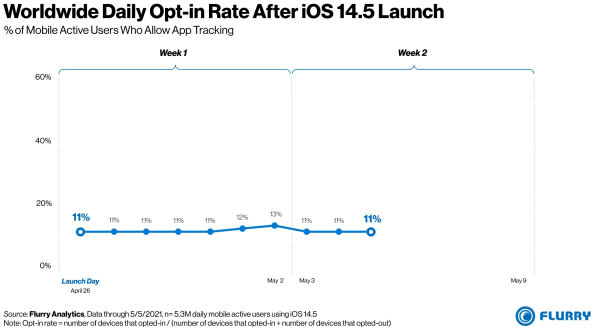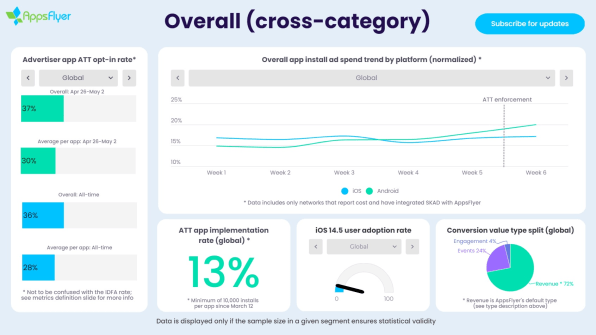With last week’s launch of iOS 14.5, iPhone and iPad users now have a say in whether their apps can track them. And so far, the results are sobering for the companies doing the tracking.
Flurry Analytics, a Verizon-owned measurement firm, estimates that just 11% of users worldwide are opting into tracking in iOS 14.5, based on measurements of 5.3 million users. Opt-in rates are even lower in the United States, where just 4% of users are allowing themselves to be tracked.
Not all estimates are quite so dire. The marketing analytics firm AppsFlyer found that users have opted into tracking 37% of the time globally in the first week after iOS 14.5’s public launch, and 29% of the time in the United States. (AppsFlyer declined to comment on the difference in results, and Verizon did not return a request for comment, but the companies may be using different methodologies to measure eligible users.)


It should come as no surprise that most users are opting out of this behavior now that they have a choice.
Starting with iOS 14.5, apps can’t access this identifier unless they ask for permission up front. And if a user declines, Apple has a list of additional rules that it expects apps to follow. For instance, it prohibits them from selling location data or email addresses to data brokers, using third-party analytics tools that help enable ad targeting in other apps, or sharing unique identifiers of any kind with third-party ad networks.
It should come as no surprise that most users are opting out now that they have a choice, though as AppsFlyer notes, there may still be some room for persuasion.

Shani Rosenfelder, AppsFlyer’s head of content and mobile insights, says these figures reflect the varying levels of trust people have in different kinds of apps.
“This message of, ‘do you allow this company to track your activity?’ it can be a little bit alarming,” Rosenfelder says. “If I know this brand, and I’ve done business with this brand . . . the chances of me to allow this are greater.”
AppsFlyer also found a 35% gap in consent levels between developing and developed markets, perhaps reflecting a greater awareness of privacy issues for the latter group. In the gaming category alone, the firm measured an opt-in rate of 47% in Brazil, vs. 18% for the United States.
It takes two
One other nuance to consider: As the ad tech industry analyst Eric Benjamin Seufert has noted, a single app opt in isn’t enough to facilitate tracking. If Facebook advertised a mobile game, for instance, the user would need to allow tracking in both Facebook and the game itself to fully measure the ad’s effectiveness. In other words, marketers’ ability to track users in iOS 14.5 could be even lower than what opt-in rates suggest.
How the advertising industry will respond is still hard to say. Some apps may try to craft messages that persuade people to let themselves be tracked. AppsFlyer expects that many developers will come to rely on Apple’s own ad measurement tools, which are more limited but also more private. Some brands may pump more ad money into Google’s Android ecosystem instead—something AppsFlyer says is happening already—and some app makers may decide to pursue different business models. Some apps may even look for ways to sneak around Apple’s rules.
But for users, the outcome looks a lot like when iOS and Android added ways to minimize location tracking in 2019. When given an easier way to protect their privacy, most users are going to exercise it.
May 07, 2021 at 11:00AM
https://ift.tt/3eURX44
iOS 14.5 app tracking: Opt-in rates are dismal so far - Fast Company
https://ift.tt/2ZaIe2Q
iOS
:no_upscale()/cdn.vox-cdn.com/uploads/chorus_asset/file/22686894/backboneonexbox.jpg)
No comments:
Post a Comment